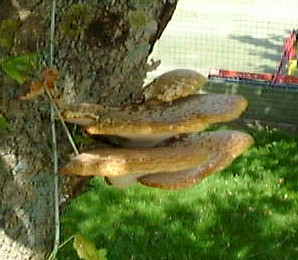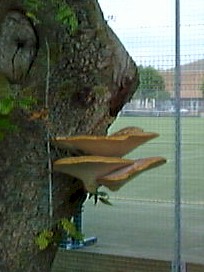 Common Name(s):
Common Name(s):Dryad's Saddle (Polyporus squamosus) |
 Common Name(s):
Common Name(s):
Scientific Name(s):
Polyporus squamosusType:
FungusPrinciple Host Trees & Shrubs
: Most deciduous trees favouring Sycamore, Beech, Elm and Ash.
Description, Development & Diagnosis:
The fungal bracket is fan shaped and appears annually during the summer. The fungus is parasitic, feeding upon the heart wood of its host tree, it creates the fruiting bodies (brackets) as part of its reproduction process; it is the fruiting bodies that produce and release the spores into the air.
It has a yellowish upper surface painted with light brown scales; white below. The flesh smells of meal and is initially succulent becoming dry and corky with age. The bracket grows on a stalk, sometimes in clusters. The brackets can reach a size of up to half a meter across.

It can be found on low stumps but is usually seen further up the bole. It is especially common on old pruning wounds.
Significance:
This fungus is common and widespread in Britain and Europe. It is a parasitic decay fungus producing an intensive white rot within its host tree.
Control:
None.
| Further Information. |
© 2001 Chris Skellern. AIE. Home | News | A-Z Index | Resources | Contact AIE | Terms of Use